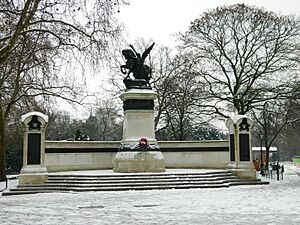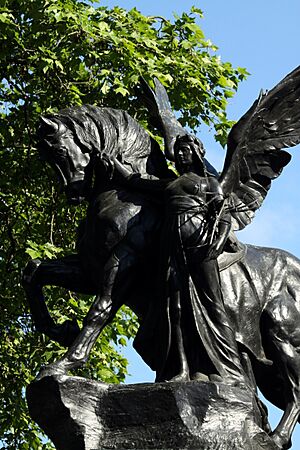Royal Artillery Boer War Memorial facts for kids
The Royal Artillery Boer War Memorial is a special monument in Central London. You can find it on the south side of The Mall, near St James's Park. This memorial was officially opened in 1910. It remembers the 1,083 soldiers from the Royal Artillery who died in the Second Boer War. That war happened between 1899 and 1902. This important monument has been a listed building since 1970, meaning it's protected for its history.
Contents
What is the Royal Artillery Boer War Memorial?
This memorial is made up of several bronze statues. These statues were created by an artist named William Robert Colton. They sit on a square stone base, in front of a curved stone wall. All of this stands on a granite platform with five steps leading up from The Mall.
Who Designed the Memorial?
William Robert Colton designed the bronze sculptures. He had also made another similar memorial in Worcester in 1908. The stone parts of the memorial were designed by Aston Webb. He was working on a bigger project to improve The Mall at the time. This project also included changes to Buckingham Palace. The memorial faces other important landmarks like the Duke of York Column.
What Do the Sculptures Show?
On top of the tall stone base, there is a life-sized bronze statue of a horse. This horse represents the "Spirit of War." Next to it is a winged figure of Peace, holding an olive branch. Sometimes, this figure is called Fame.
Near the top and bottom of the stone base, there are bronze pictures. These pictures show scenes from the war. You can also see the motto of the Royal Artillery here: "UBIQUE" (which means "everywhere") and "QUO. FAS / ET / GLORIA / DUCUNT" (meaning "where right and glory lead").
Along the curved wall, there are more bronze plaques. They say: "ERECTED BY OFFICERS AND MEN OF THE ROYAL ARTILLERY IN MEMORY OF THEIR HONOURED DEAD IN SOUTH AFRICA 1899-1902."
Remembering the Soldiers
At each end of the curved wall, there is a stone pillar. These pillars have more war scenes and bronze wreaths. The sides of the pillars list the names of all 1,083 soldiers who died. This includes some who passed away even after the war ended in May 1902. The names of 61 officers are listed together.
When the memorial was first built, these name panels were on the floor. People complained because visitors were accidentally stepping on the names. So, the panels were moved to the walls instead.
When Was it Unveiled?
The memorial was officially opened on July 20, 1910. Prince Arthur, Duke of Connaught unveiled it. Before the unveiling, there was a special service at St Paul's Cathedral. An electric signal was sent from the cathedral to drop the flags covering the memorial.
Its Importance Today
The Royal Artillery Boer War Memorial is listed as Grade II* on the National Heritage List for England. This means it is a very important historical building. Experts describe it as a "war memorial of clear architectural and sculptural quality."
Other Works by the Artist
William Robert Colton also used a similar sculpture design for the Staffordshire County War Memorial. This memorial was finished in 1923, after Colton had passed away.
Images for kids




